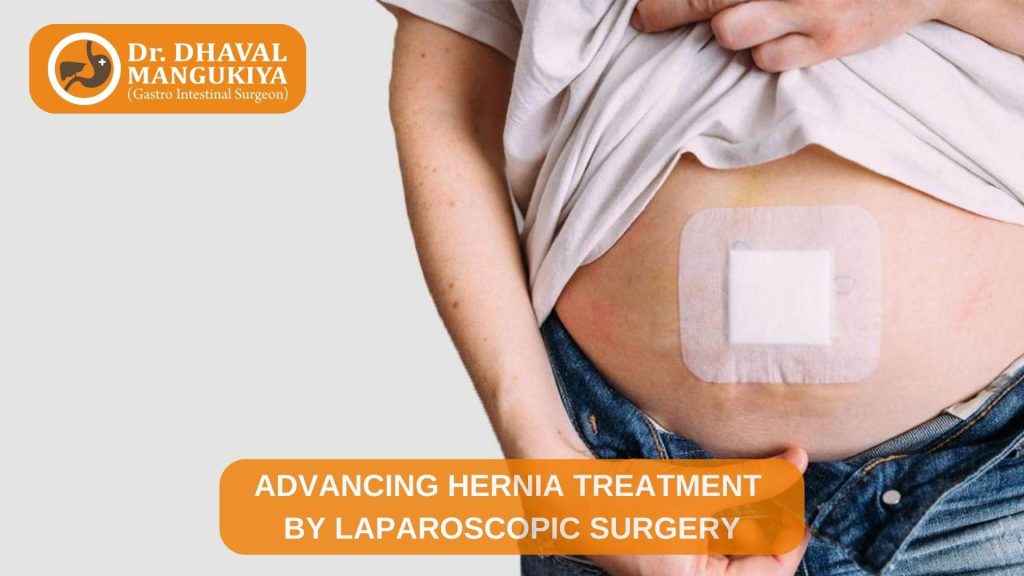Hernias, those pesky protrusions of tissue through weakened muscles, are more common than you might think. While the traditional approach to hernia repair involves open surgery, the advent of laparoscopic surgery has revolutionized the treatment landscape, shares Dr Dhaval Mangukiya, one of the best laparoscopic surgeons in Surat. In this blog, we’ll explore the benefits, procedure details, and recovery aspects of laparoscopic surgery for hernias.
The Evolution of Hernia Treatment
Historically, hernia repair involved open surgery, where a large incision was made directly over the hernia, allowing the surgeon to push the protruding tissue back into place and strengthen the weakened muscle with stitches or a mesh. While effective, this method came with its share of challenges, including longer recovery times, increased pain, and a higher risk of complications.
Enter laparoscopic surgery, a minimally invasive technique that has transformed hernia repair. Laparoscopic procedures utilize small incisions through which a camera and specialized instruments are inserted, providing the surgeon with a detailed view of the affected area. This approach not only reduces trauma to the body but also offers several advantages over traditional open surgery.
The Benefits of Laparoscopic Hernia Repair
The benefits of minimally invasive surgery for Hernia are many, points out Dr. Dhaval Mangukiya, one of the best gastro surgeons in Surat:
1. Smaller Incisions, Less Scarring:
Laparoscopic surgery typically involves three to four small incisions, each about half an inch in length. These incisions result in minimal scarring compared to the larger incision required in open surgery. This cosmetic benefit is particularly appealing to patients seeking a less conspicuous reminder of their surgical experience.
2. Faster Recovery:
The smaller incisions not only mean less visible scarring but also contribute to a faster recovery. Patients undergoing laparoscopic hernia repair often experience less postoperative pain, enabling them to resume normal activities more quickly than those undergoing traditional open surgery.
3. Reduced Risk of Infection:
With smaller incisions comes a decreased risk of infection. The minimally invasive nature of laparoscopic surgery lowers the chances of complications associated with wound infections, promoting a smoother recovery process.
The Laparoscopic Procedure for Hernia Repair
Laparoscopic hernia repair involves a few key steps, each contributing to the overall success of the procedure:
1. Anaesthesia:
The patient is placed under general anaesthesia to ensure they are completely unconscious and pain-free throughout the surgery.
2. Small Incisions:
The surgeon makes three to four small incisions near the hernia site. These serve as entry points for the camera and specialized instruments.
3. Insertion of Trocars:
Trocars, or narrow tubes, are inserted through the incisions. These allow the surgeon to access the abdominal cavity and perform the repair.
4. Visualization with a Camera:
A laparoscope, a thin tube with a camera at its tip, is inserted through one of the trocars. This provides a magnified and illuminated view of the internal structures on a monitor, guiding the surgeon throughout the procedure.
5. Hernia Repair:
The surgeon uses specialized instruments to push the protruding tissue back into place and reinforces the weakened muscle with stitches or a mesh.
6. Closure of Incisions:
Once the repair is complete, the trocars are removed, and the small incisions are closed with sutures or adhesive strips.
Postoperative Care and Recovery
Recovery after laparoscopic hernia repair is generally faster and less arduous compared to open surgery. However, Dr Dhaval Mangukiya, one of the best gastrointestinal surgeons in Surat, says there are still essential aspects to consider:
1. Pain Management:
While postoperative pain is typically less severe than with open surgery, patients may still experience discomfort. Pain medications prescribed by the surgeon should be taken as directed to ensure a comfortable recovery.
2. Activity Level:
Patients are encouraged to gradually resume normal activities. Light walking is usually recommended early on to promote circulation and prevent complications.
3. Follow-up Appointments:
Regular follow-up appointments with the surgeon are crucial to monitor the healing process and address any concerns. These appointments also allow the surgeon to assess when it is safe to resume more strenuous activities.
4. Dietary Guidelines:
Patients may be advised to follow specific dietary guidelines to support the healing process. A balanced diet rich in nutrients is essential for tissue repair and overall well-being.
Conclusion:
Laparoscopic surgery for hernia repair marks a significant advancement in medical technology, says Dr. Dhaval Mangukiya, one of the best laparoscopic surgeons in Surat, offering patients a safer, less invasive, and more efficient alternative to traditional open surgery. As with any medical procedure, it is essential for patients to have open and thorough discussions with their healthcare providers to understand the specifics of their case, potential risks, and expected outcomes.
Embracing the benefits of laparoscopic hernia repair, patients can look forward to a quicker return to their daily lives with minimal scarring — a testament to the continual progress in the field of surgical innovation. As technology advances and medical techniques evolve, the future holds even more promise for enhancing the quality of care for individuals grappling with hernias.

